The Digital Marketing Strategy of BJP (Bharatiya Janata Party)
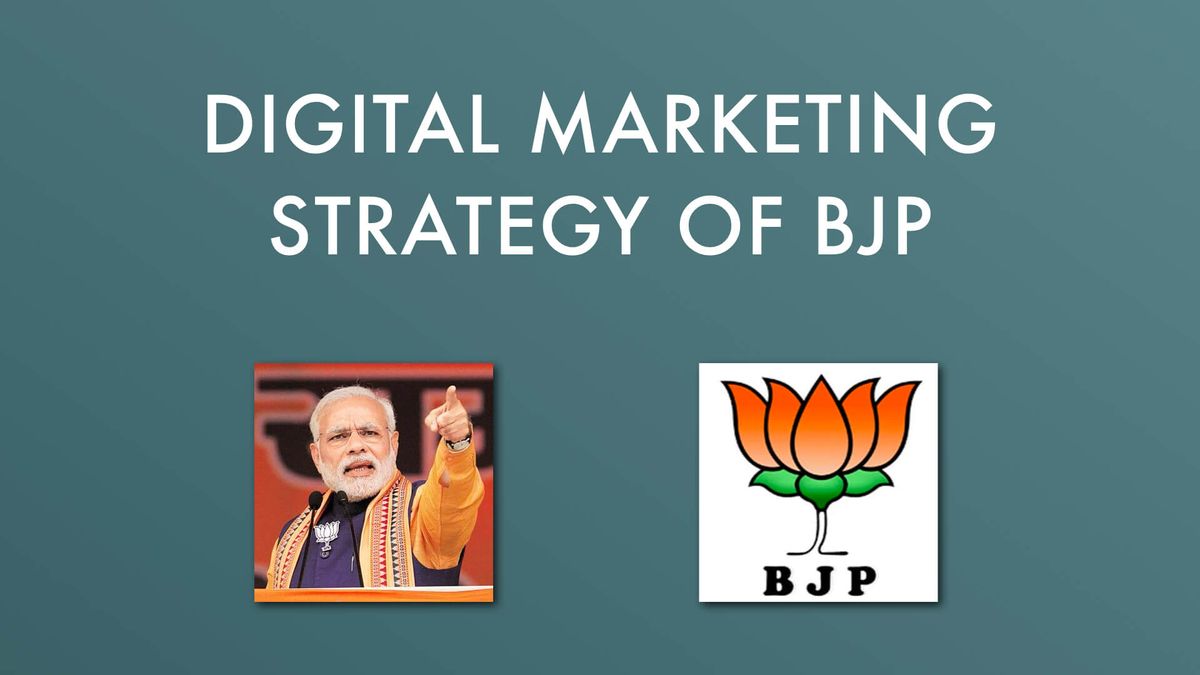
Political campaigns in India are no longer limited to traditional marketing medium. It has clearly entered the digital spectrum, and the impact of digital political campaigns are significant. It cannot be ignored anymore. That’s why in this article, I have outlined the digital marketing strategy of BJP. We have no affiliation with any political parties in India.
This article was written and published based on the demand of my readers. In the Learn Digital Marketing Group on Facebook, most of the people wanted to read about the Digital Marketing Strategy of BJP than any other political party.

Today, almost every political party has a firm online presence, especially on the most popular social media handles. All parties are relentlessly working hard in terms of appealing to their voters and attempting to garner support for the upcoming elections.
In this regard, the Bhartiya Janta Party (BJP) in particular has been making headlines for its impactful digital strides, ever since the 2014 Lok Sabha elections.
This increased focus of political parties towards digital mediums as against traditional outreach methods such as billboards and other print ads is there for a solid reason. The Internet has truly revolutionised the way people prefer to receive information and communicate with others in the community.
The mass penetration of smartphones coupled with the cheap availability of data services in India has resulted in people spending a lot of time online.
According to World Bank Stats, 29.5% of the Indian population have access to Internet. 10 years back, the internet penetration was less than 3%,
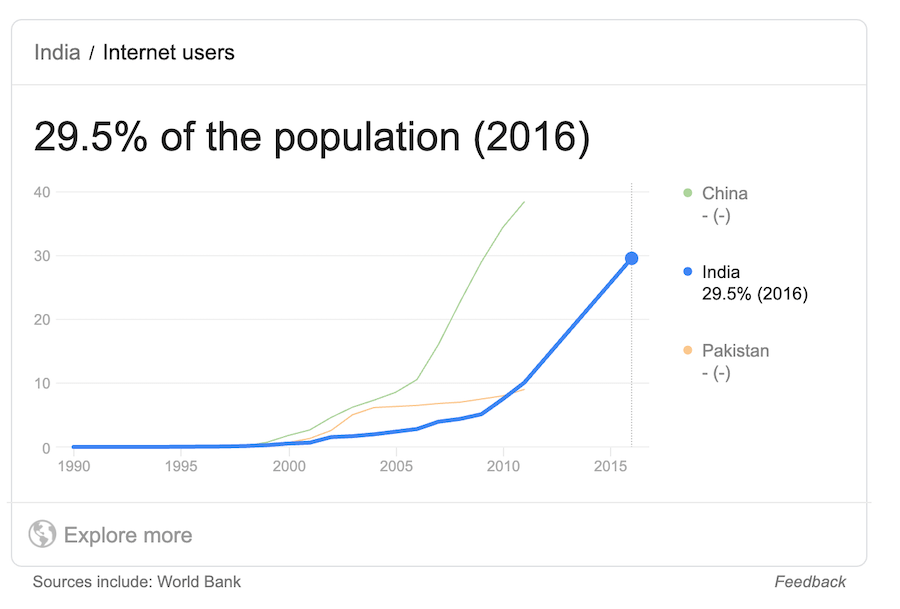
As per Statista, the estimated number of Mobile Internet users in India as of 2018 is around 430 million.
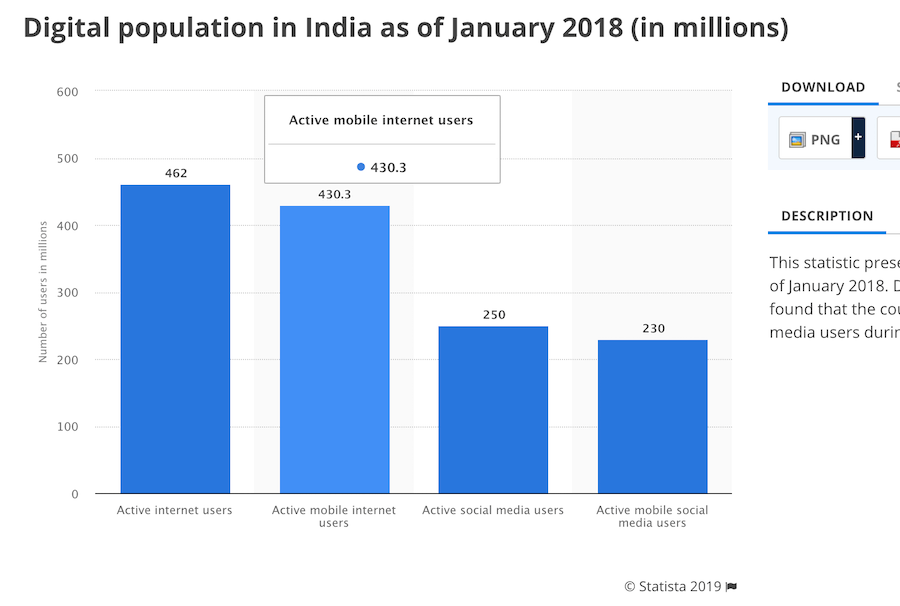
Further research suggests that most Indian Internet users typically spend time on various social media handles – the most popular being Facebook, Twitter and Whatsapp. They also rely immensely on them to consume news and other pieces of information.
Hence, in this kind of an online ecosystem, lies a significant opportunity for political parties to reach out to their mass of prospects regularly and communicate with them in an agile and cost effective manner.
Political Campaigning On Digital Media
Out of all the parties in India, Mr. Narendra Modi and his party – the BJP were among the first ones to leverage the advantages of the digital realm with their online marketing and campaigns during the 2014 general elections. However, it was Mr. Barack Obama who marked the first online footprints of politics in social media during the 2008 US Presidential elections.
Obama primarily focused on Twitter and Facebook to share his views, introduce his platform and interact with potential voters. There were reports, which suggested that his team had mined the social media footprints of Americans, created psychometric profiles of individual voters and used that to appeal to voters with tailor-made content.

Many regard his iconic victory to his impactful social media presence. “Were it not for the Internet, Barack Obama would not be President. Were it not for the Internet, Barack Obama would not have been the nominee,” Huffington Post founder Arianna Huffington said, at the Web 2.0 Summit following the 2008 election.
The point to make with all of this is simple – Digital Marketing for politics is immensely powerful and indispensable for success in elections in today’s age!
On that note, let us take a look into the digital marketing strategy of BJP – the party with the most visible digital success in India.
Digital Marketing Strategies And Tactics
Before we head on to studying and conjecturing about the guiding digital marketing strategy in place for the Bhartiya Janta Party (BJP), it’s important to first pause and understand the distinction between strategies and tactics and their relationship with a goal.
Any strategy is essentially the game plan to help meet certain goals. Tactics are the means to execute that strategy. For example, in a war, the goal would be to win over the opponent, strategy would be to divide and conquer and the tactic could be engaging in guerilla warfare.
As for understanding and discussing the digital marketing strategy of BJP, the first systematic step in the process is to gain a well-rounded sense of their objectives (which are preferably measurable). That’s what the following section talks about.
Digital Marketing Goals of BJP
Let’s try to think from the party’s shoes. What could be their goals when it comes to creating and executing a Digital Marketing Strategy?
1. Build A Solid Brand For The Party
Elections are quite an emotional subject, and that’s where the role of building a robust brand plays a significant role. Building a brand in this case essentially means developing an emotional and memorable connection for the masses with the party, its key individuals, guiding ideologies and agenda.
2. Generate Enough Excitement Before The Actual Voting
Simply building an emotional connection with the party is not enough. There also needs to be a continuous buzz of excitement and engagement, which needs to be maintained to keep the enthusiasm and momentum alive. After all, elections are a big event with a big outcome that demands ongoing interest and active participation of the masses.
3. Mobilize People To Show Reaction
Along with generating interest, it’s also important to ignite a response and reaction of sorts. That helps to consistently test their sentiments and at the same time leverage it to inspire others in the form of social proof.
4. Disburse Region-wise Personalised Content Digitally
Last, but not the least – Digital is an excellent, agile and cost effective medium to reach out to the masses and interact with them with personalized and tailored content. Leveraging digital is also driven by the goal to target the maximum number of people possible at a high frequency, and convince them by talking to each of them with the right mix of words – in the language they appreciate.
Now, with an understanding of the basic goals guiding the digital marketing framework, let’s move on to explore the strategy that appears to be working for the BJP.
The Digital Marketing Strategy of BJP
In order to arrive at the digital marketing strategy of BJP, my team and I closely followed their online footprints and observed their actions across the different digital channels.
A snippet of their revealed action plan from our study is described below:
1. Start Early, Build Momentum & Expedite
The BJP has been paying careful attention to regularly reaching out to the voting population, engaging with them and slowly turning them into brand evangelists. Their approach to delivering communication is very well planned; right with starting in good time to slowly building momentum to amplifying pace as the elections come closer.
When it comes to digital media, even for a political party, it is very important to be consistent in communication sequence and timing and treat it as a typical sales funnel.
The conversion in this case is measured as a vote in favor of the party. Each potential voter needs to be moved through the stages of a funnel the AIDA:
- Attention towards the party’s actions, Awareness about its political agenda, Guiding ideologies and key leaders,
- Interest in their activities,
- Desire for making the right decision and
- Action in terms of voting for their candidates.
As a fact, it has been their timely and early action that has been giving them a sizeable advantage. If we talk about the last elections, Mr. Modi had a clear advantage by being the first mover in the digital space.
When major political personalities started taking digital medium seriously by Mid-2015, Mr. Modi already had 16 million followers combined on Twitter and Facebook.
As of now, Mr. Modi has 43 million followers on Facebook and 46.8 million followers on Twitter.
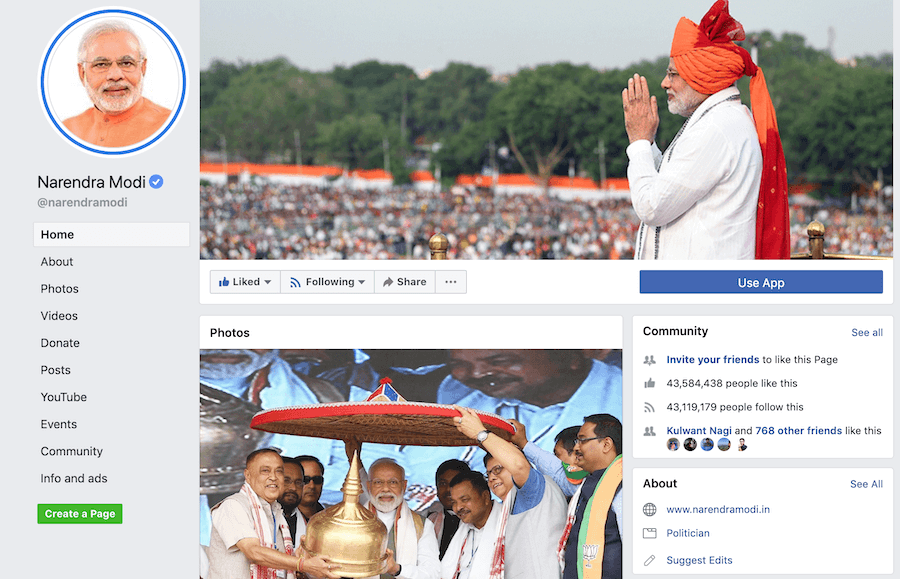
The kind of content that is being posted on Twitter and Facebook are slightly different, probably targeted at different sets of audiences who use these platforms frequently.
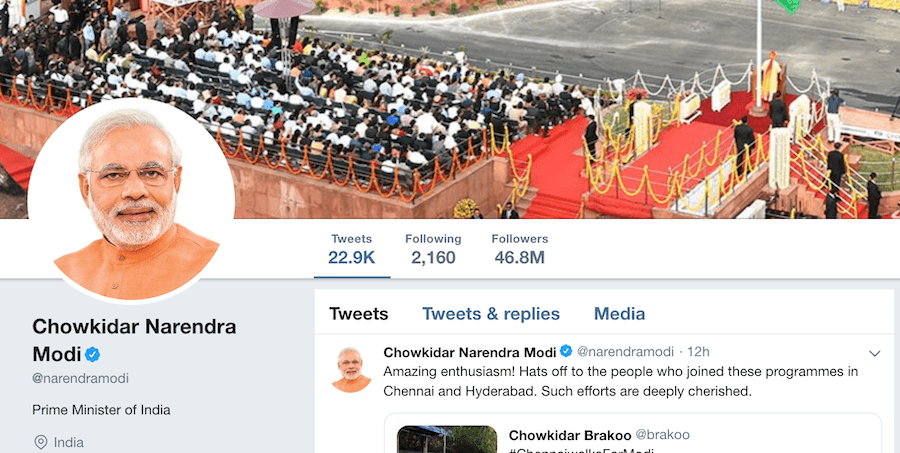
This timely intervention and consistency has been showing its visible impact even up to present day.
2. Target Everyone, But In A Segmented Manner
Even when marketing a political party on digital mediums, the importance of relying on fundamentals remains unaltered. Any good digital marketing plan takes into account the psyche of the target group minutely and carefully caters to the needs and aspirations of that group.
Understanding and targeting the different target persona with a tailored approach is something that BJP’s digital team has been doing minutely and religiously, just like Obama did.
As a party contesting for seats in the general elections, their target audience primarily includes everyone who is a citizen of India with a voter’s ID card. Breaking it down, it includes the entire demography of 18+ including both men and women across all income groups.
If we segment it further, it includes first time voters, repeat voters, thinkers and influencers, observers, the marginal communities to mention a few.
The BJP’s strategy is to pay special care and cater to the motivations of each of these different groups and segments by delivering different and customized messaging, appropriate to each of them.
3. Nurture Attachment & Loyalty
Along with consistently reaching out to all the target individuals with the right customization, the communication plan of BJP has been heavily banking on channelizing the emotions of the masses in order to build a very strong connect with their party.
Their digital marketing team very well understands the role of emotions in guiding the voting behavior, and their digital campaigns demonstrate that fact very well.
It is important to understand here that any decision ultimately is made out feelings and smart marketers tap that with expertise. While rationality might be the first step of decision making for many, the final call for almost all is always based on a their perception of they think they will end up feeling when they make the choice.
In that regard, the fear of taking the wrong decision, aspiration of seeing a better India, a brighter flourishing future for themselves, experiencing the ego boost and happiness from making right political choices are some of the dominant emotions that BJP’s digital marketing strategy has been playing with in order to influence their audiences.
4. Bring Attention To The Party’s Achievements
In addition to attempting at roping in loyalty with powerful emotional play, the BJP has also been neatly and concisely highlighting actual facts about the party’s achievements over their last tenure to appeal with a cause.
Their communication has also been carefully designed to showcase their progressive ideologies. It brings to light, the tangible and measurable progress that they have made over the last 5 years. At the same time, the communication plan systematically reminds the masses of what the previous government failed to achieve, and have projected that as a comparative advantage.
6. Be Present Everywhere To Be Visible & Remembered
With digital, it is possible to be present everywhere at a fairly low marginal cost, and in that respect, the BJP leaves no significant channel untapped. Being perpetually visible and omnipresent helps to build trust and secures a strong spot in the memory.
In order to take advantage of that, the BJP has a holistic digital media presence. Whether it is about owning websites or creating pages in the different social media channels, they are simply everywhere their target audience possibly hangs out.
Their prime focus lies on leveraging the family: Facebook, Whatsapp and Instagram, as 95 percent of the social app usage in India is clustered there as per the Omidyar Network report (December 2017). They’re also quite strong on Twitter. In my opinion, being present on Whatsapp is one of their game changing moves, and I’ll share details on that in the next section.
7. Ensure Maximum Reach & Engagement
With the clutter that prevails in the online ecosystem, organic reach is not enough to reach out to everyone. Engaging in proper paid advertisements with the right kind of profiling is essential to communicate with the different kind of target groups with customized messaging.
In that regard, the party is investing heavily with a big sized budget in paid promotions across the different platforms. While the exact numbers on the total BJP online advertising spends will be difficult to share at this point, as the ongoing expenditure is only increasing as the polls come nearer, the estimates from the month of February 2019 can give you an idea.
As published in the Economic Times, BJP leaders involved in election-related publicity hinted that social media spending will account for 20-25% of the party’s total ad spend by the time campaigning is over.
8. Integrate Online Marketing With Offline Efforts
Finally, the BJP recognizes the importance of an integrating marketing campaign. They don’t rely on digital marketing as an end, but as a means to the end. Their online efforts are well in sync with their offline efforts, and work collaboratively towards influencing the masses to turning into staunch BJP loyalists.
Now, with an understanding of the party’s goals and accompanying strategies, let’s move on to studying the actual tactics deployed by their digital marketing team.
The Digital Marketing Tactics of BJP
In the following section, I have looked into the different tactics employed by their digital marketing team to execute their revealed digital marketing strategy across the various aspects.
I’ve also shared real case examples to demonstrate my views on their execution illustratively.
1. Multiple Social Media Pages
The Digital Marketing team of BJP has been working carefully towards profiling their audience minutely. They’ve identified all the different types of voter groups and have created multiple well thought out pages to appeal to the various voter segments.
While some of the pages are generic to the party and have been created a long time back, others are freshly made for specific focus groups, and to execute innovative campaigns.
Each of the pages under the BJP umbrella demonstrates immense thought clarity, and the nomenclature signifies a kind of collaborative virtue towards a common goal.
Some of their interesting and impactful pages on Facebook include:
My Gov India (Official)
This page was created in March 2015, after the party came into power. It has ever since focused on building and nurturing a continued trust in the work carried out by their party by invoking feelings of dependability and transparency.
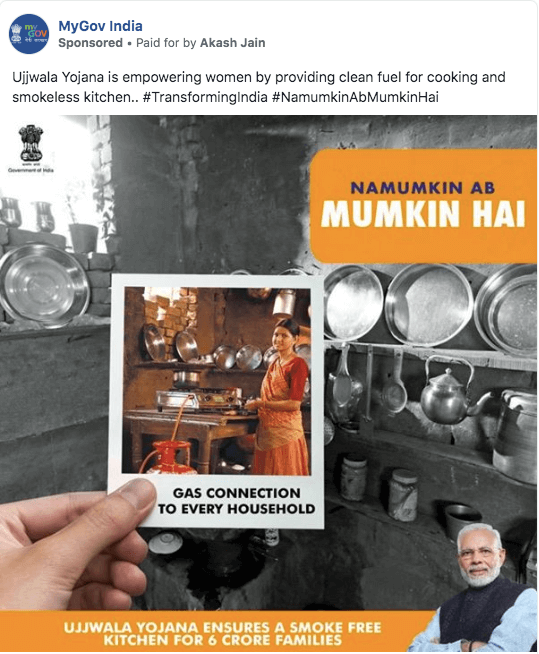
As such, it targets all the citizens of India: across all age groups and geographies. The content of this page mainly highlights the achievements of the BJP government in positively transforming India across varied aspects – right from building more homes, to providing smokeless fuel for cooking to building a cleaner nation.
My First Vote For Modi (Unverified)
[Note: This page is not verified by Facebook, so we are not sure if it is an official page or a page created by fans of BJP. From the about page, it links to MyFirstVoteForModi.com. The whois database of this domain is private, so there is no way to confirm if it is by BJP itself.]
The page was created in January 2019 to entice first time voters by tugging at their aspirational chords, and shaping their loyalty as BJP supporters on grounds of pure rationality – just the way this budding age group like to be convinced.

It is important to note that this segment is quite crucial for the party. If you extrapolate the data from the last census, there should be about 10 crore first time voters, which means they can’t and must not be ignored.
The content under this page primarily highlights achievements that are most likely to resonate with the young, first time voter population.
It talks about positive developments brought about by the BJP in terms of more promising career opportunities, growth of entrepreneurship with Make In India, availability of cheap data as some of the examples.
Along side, it takes a fact-backed dig at the opposition parties by highlighting some key points of their failures, which the BJP visibly overcame.
Bharat Ke Mann Ki Baat (Unverified)
Created recently in January 2019, this page is all about making the people of India feel empowered. It maybe regarded as an online version of the radio show ‘Mann Ki Baat’.

It has been designed to act as a social media forum that urges the people of India to share their views and make them feel heard. It really strikes an instant connect, which originates from a feeling of being valued and regarded as important.
Modi 11 (Unverified)
Leveraging the cricket fanaticism of the Indian population at large, this page, created in March 2019 in the cricket season, is quite an interesting take on trend jacking.
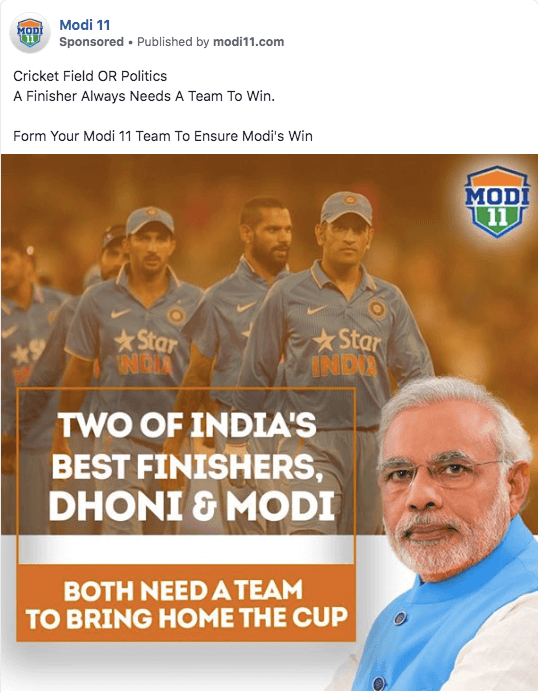
The content on this page primarily encourages people to form teams of 11, like in a cricket team, and demonstrate their support towards the virtues of the Modi Government. It also highlights two important victories for ‘true’ Indians in 2019 – India winning the World Cup in cricket and Mr. Modi winning as Prime Minister in the Lok Sabha polls. It’s a remarkable move to grab people by the pulse, and convince them in the way they’re likely to be convinced the most.
Nation With Namo (Unverified)
Created in June 2013, this page has been quite an old and influential one with regards to gaining support by endorsing the popular supporters and the party’s achievements.
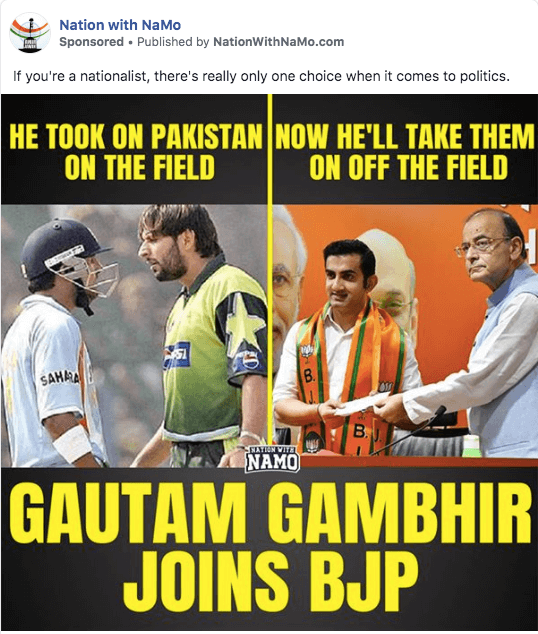
It invokes a feeling of a trust backed by an existing large support system, which can compel and encourage new individuals to join their club.
It showcases influencers who have been supporting or are supporting Narendra Modi and the BJP Government. Additionally, it points a finger at the opposition, while highlighting the party’s strong points.
2. Creation Of Multilingual Content
While English and Hindi are the two dominantly spoken languages in India, there are many regions where local languages are much more popular.
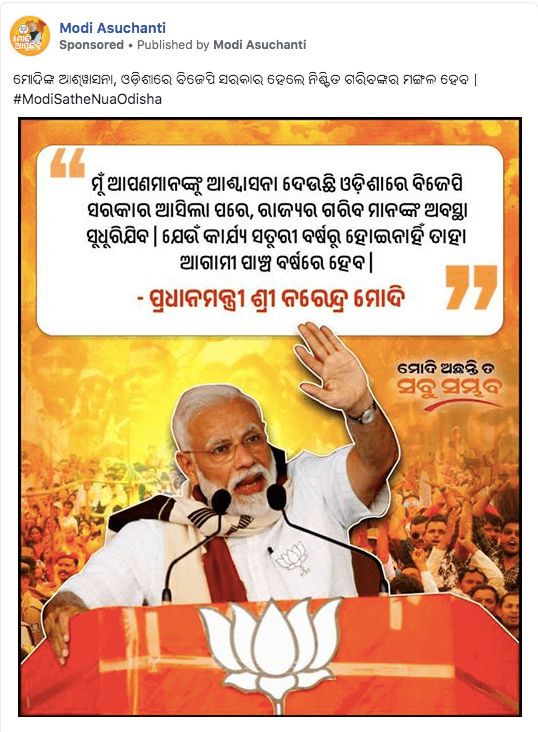
The digital marketing team of BJP has taken special care to address even those regions with the vernacular tongue, so as to not miss out any chances of resonating best with them.
Along with English and Hindi, there are posts made in local languages for regional pages. In many of their generic India wide pages too, the same content is shared in multiple languages and promoted in custom geographies to ensure the maximum connect.
3. Focused Pages For Certain Regions
In order to cater to people of certain regions with specialized focus, the BJP has created regional pages to interact with voters of that region with a customized content plan.
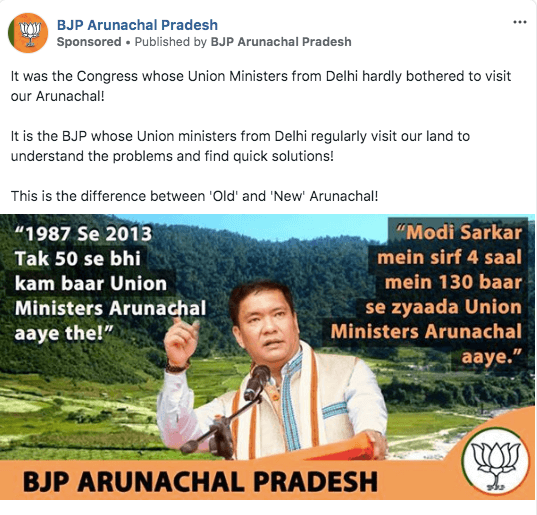
In those pages, the core content mainly covers the key issues of interest, only specific to that region. Moreover, content is shared in the most popular languages of that state.
4. Working On All Content Formats
As for content creation formats, they’ve been very ambitious, aggressive and invested in all types – right from static designs, to videos, live videos, memes, comic strips and infographics. They have been using consistent colors and tones to ensure proper branding and delivery of clear, high impact messaging.
For example, Mr. Modi also has a verified YouTube Channel where he has 2 million subscribers. All the videos combined has got 228 million views so far.
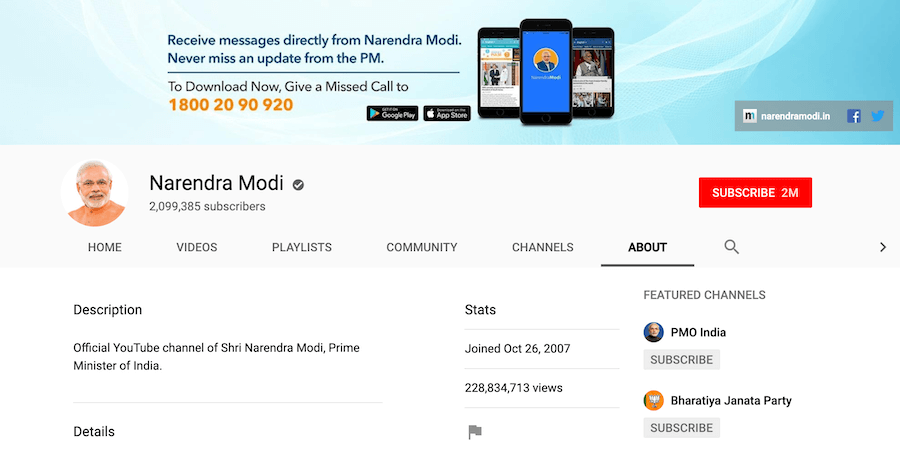
Along with sharing facts and achievements in favor, there is also a significant storytelling approach in their communication to capture the attention of different focus groups and at the same time, keep it alive.
As a special mention, the digital team of BJP has been working extensively on videos and lives videos – a move that is backed by pure logic and facts, in a localized environment of easy data access for all.
As per a survey, 67 percent individuals claim that video content (43 percent specifically for the live videos), as a format is most transparent. Invoking a feeling of transparency is critical for a political party contesting for central governance and the digital marketing team knows that just right.
Moreover, the PM comes himself to interact with the public on live videos from time to time. The political campaigns on a PAN India basis are also showcased online in real time across Facebook and Instagram. Along side, the digital teams extensively distribute and amplify their video content to generate enormous amount of engagement and shares.
5. Intelligent Use Of Whatsapp
The tactical use of Whatsapp to disseminate content deserves a striking mention, as this single move is turning out as an answer to executing most of the strategic plans.
[Note: There is no way to verify how many Whatsapp groups have been created by BJP and how many are by fans. We have no way to know as of now until Whatsapp brings verification for groups.]
As a first, most of the Internet users in India use the platform for messaging, which makes it very universal. Secondly, the communication that they receive and share on the platform garners significantly higher attention and interest level as it is sent and received among a known sender network.
Going by the facts, the success from Whatsapp usage in the 2018 Karnataka Assembly election campaigning validated the effectiveness of the messaging platform in influencing political outcomes. Its application is being scaled up now for the upcoming 2019 general elections.
Earlier, the party had created somewhere between 23,000 to 25,000 groups for the purpose. Simply, repeating that model as a national template is now expected to give significant results. With each Whatsapp group having an allowable limit of 256 members, there can be multiple groups created. (Sources mentioned at the end of this article).
If each of the 29 states to target have 15,000 groups each, the total targeted population will add up to about 110 million citizens. If we revisit the victory numbers from the 2014 Lok Sabha Elections, it was near about 170 million votes that contributed to BJP’s win.
6. Engaging Contests For The Youth
In order to build social proof and effectively engage the audiences, contests have been intelligently deployed in the strategic executional framework of BJP’s online campaigns.
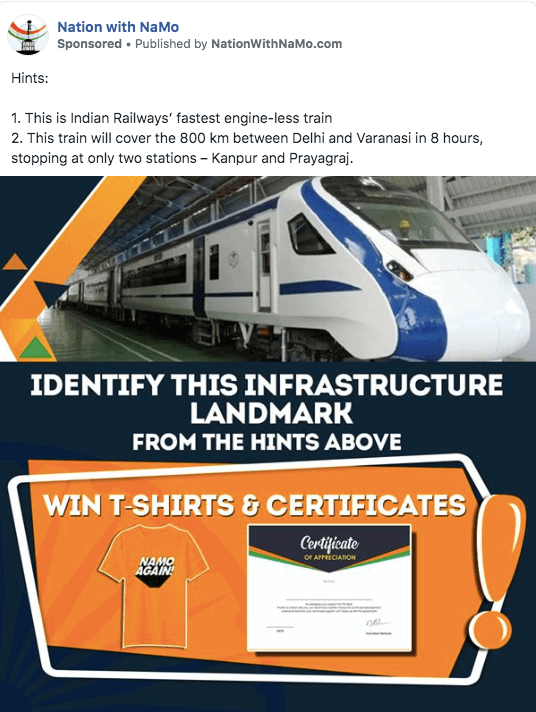
There have been several interactive quizzes and contests that are quite smartly planned, right from the contest questions to the target group it is for, and the giveaways of course!
The contests under the ‘My First Vote For Modi’ Facebook page are quite appealing and are just right to excite young voters. Young people have been urged to guess some of the achievements of the party shown in pictorial format.
Alternately, they’ve been urged to show their support and win attractive funky giveaways in return. The contest prizes include merchandise that are designed to be specifically interesting to the target group such as certificates of appreciation, mobile covers, badges and t-shirts in striking colors and catchy slogans that lend further robustness to the party’s name. On winning, if the youth use these goods in public, it will only further strengthen the party’s cause.
7. User Generated Content
In order to generate high interest and engagement levels, and at the same time make individuals feel important, the BJP’s content strategy has been paying significant attention to user generated content types.
They understand that people are much more likely to hear, trust or associate with a cause when they’re convinced by someone from their circle instead of a political figure, and with that they’re creating their own army of brand evangelists.
Inviting views from individuals under the campaign ‘Bharat Ke Man Ki Baat’ or encouraging them to join hands under the ‘Main Bhi Chowkidar’ campaign are powerful examples of dotting social media with striking user generated content, and building and maintaining interest.

In particular, the latter example has been generating enormous amount of traction recently. Leaders of the party, and citizens are seen updating their names on social media and thereby showing their support by prefixing the word ‘Chowkidar’ to their names.
Under the umbrella of this campaign, the PM had also interacted recently with people across the nation, further adding on to this wave of user-generated content and engagement.
Moreover, there is also a lot of social proof shared under the page My First Vote for Modi where pictures and views of first time voters are being shared as an endorsement of their support for the BJP. They’ve also showcased how people initially criticizing Modi have actually realized and turned grateful for the tangible results and progress made under his governance.
In fact, the examples of the digital marketing strategy leveraging user-generated content are many, and each one in its own way is solidifying the party’s stellar online repute.
8. Piggybacking On The Fame Of Global Personalities
The BJP has also been being quite intelligent in highlighting their achievements and at the same time borrowing some credibility from sharing photographs of their key face – Prime Minister Modi with some prominent global personalities.
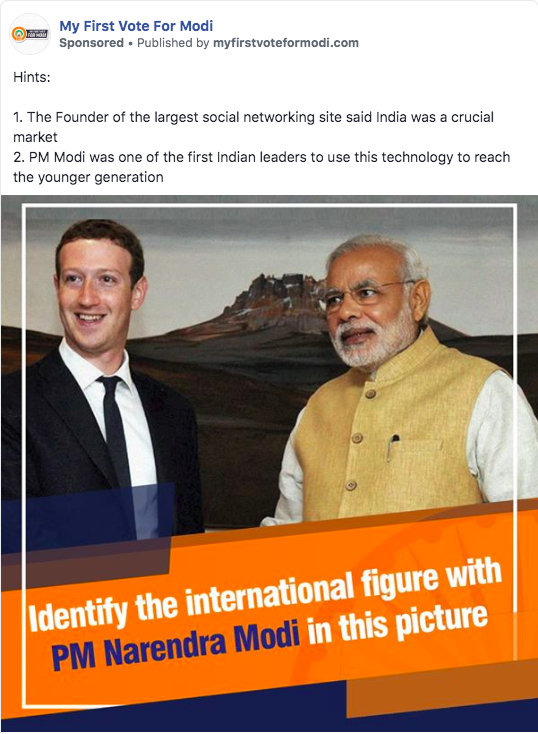
As a part of one of their contests, the questions ranged from identifying the person in the picture with Modi. These individuals ranged from prominent and popular heads of states to entrepreneurial icons like Marc Zuckerberg of Facebook, Sundar Pichai of Google, and Bill Gates of Microsoft with an immense following count.
On the other hand, in the page ‘Modi 11’, they’re leveraging the fame of Dhoni to win the attention and interest in their favor. Finally, the ‘Nation With Namo’ page is all about sharing the association of powerful influencers with the Modi government to appeal to all kinds of audiences.
9. Digital Raths in Delhi NCR
This one has been quite an innovative tactic in BJP’s digital marketing armor, and points towards the synchronization of their online and offline marketing efforts.
Digital Raths are basically chariots that are being used to play video reels of the party’s achievements, and needless to say, highlight failures of the opposition – the Kejriwal Government in the Delhi NCR region.
These raths are offline, but digital at the same time due to their functionality offered. They have a built-in Wi-Fi spot, and the password for using it is ‘Kejriwal failed to give free Wi-Fi’.
10. Sponsored A Movie?
With a biopic “PM Narendra Modi” scheduled for release, just one week before the elections, there are of course a lot of speculations raised whether it has been a tactical move by BJP to increase their popularity and influence the voting outcomes. While the BJP has denied association with the movie production, it is an area of doubt for many.
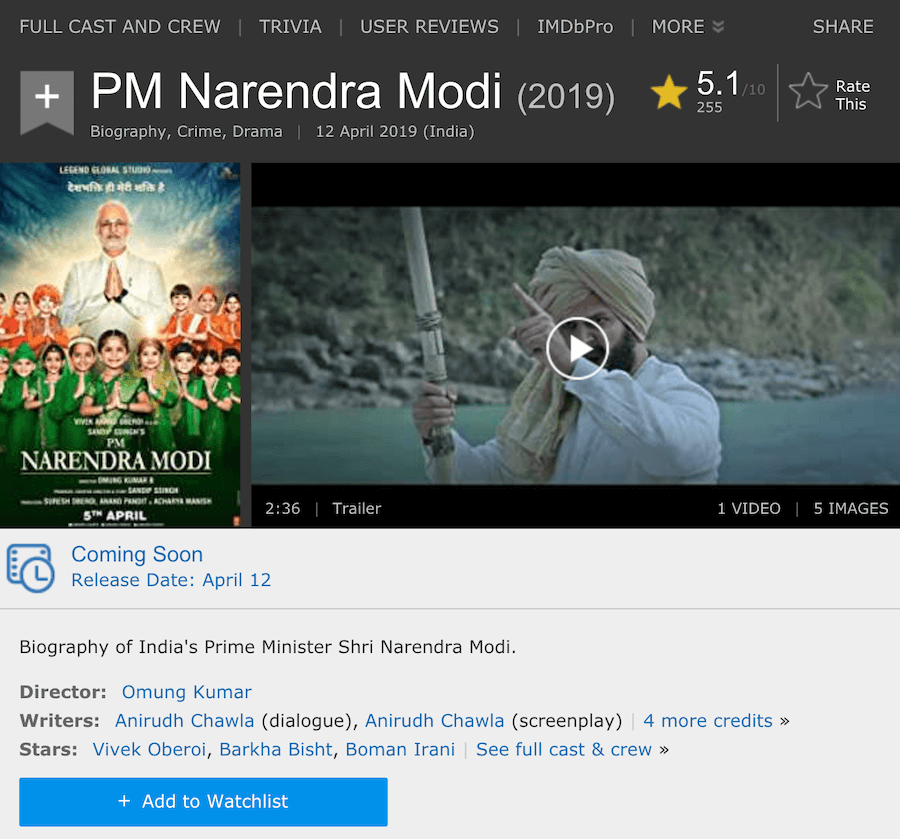
Irrespective of who so ever is behind it, this movie can really turn out to be a tangible game changer to woo individuals, make them spend a couple of hours paying full attention to Modi and as a result, get systematically Modi-fied.
If pictured well, this digital content format could be a great way to convince and convert a large chunk of the masses into BJP fans and voters.
11. Building A Network of Fans
Finally, all of these tactical executions have one underlying tactic in common: the existence of a powerful digital force and volunteer network to make the successful execution at this scale possible. It goes without saying that the larger the network a party has, the better its results from its digital marketing outreach are.

Talking in terms of actual numbers, the BJP has plugged in efforts to maintain the largest trained digital cadre and volunteer network. As confirmed by the party’s national information and technology in-charge Amit Malviya, it has 1.2 million volunteers to its credit.
A noteworthy point to make here is that the BJP nurtures advocates on their side very well. In fact, they’re so responsive; that they make them feel extremely valued in the minutest way, which shows up in the way they operate. There was once a picture of Prime Minister Modi with a scarf on which a volunteer made an appreciating comment. She was simply gifted the same scarf the next day.
In short, their offline efforts are well in sync with their online ones. This has been a strong enabling force in terms of building and owning the ideal infrastructure needed to achieve online digital marketing success.
12. Paid Advertising Campaigns
I’ve kept the most important part for the last. Do political parties like BJP invest money in paid advertising online to boost their marketing? Yes, they do.

According to Facebook’s Ad Library Report, there were 50,000+ political ads with a total spending of more than 10 crores INR between February and March 30 this year, with a major chunk coming in from BJP and its supporters.
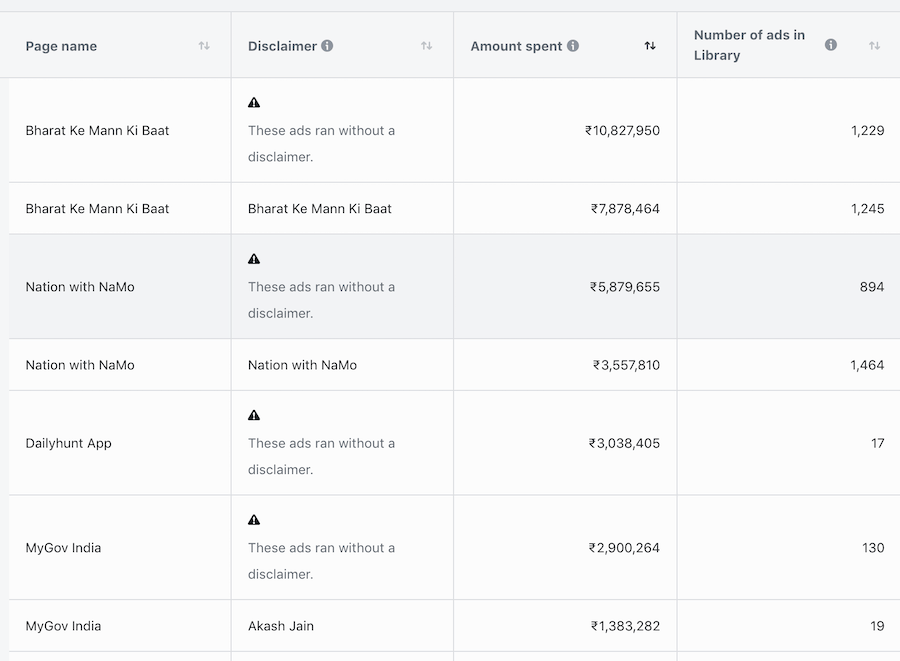
‘Bharat Ke Mann Ki Baat’ page is the top spender with almost 1 crore INR per week spend and more than 1,200 Ads in the library. Apart from Facebook, they might be spending money on Google Ads and YouTube ads as well.
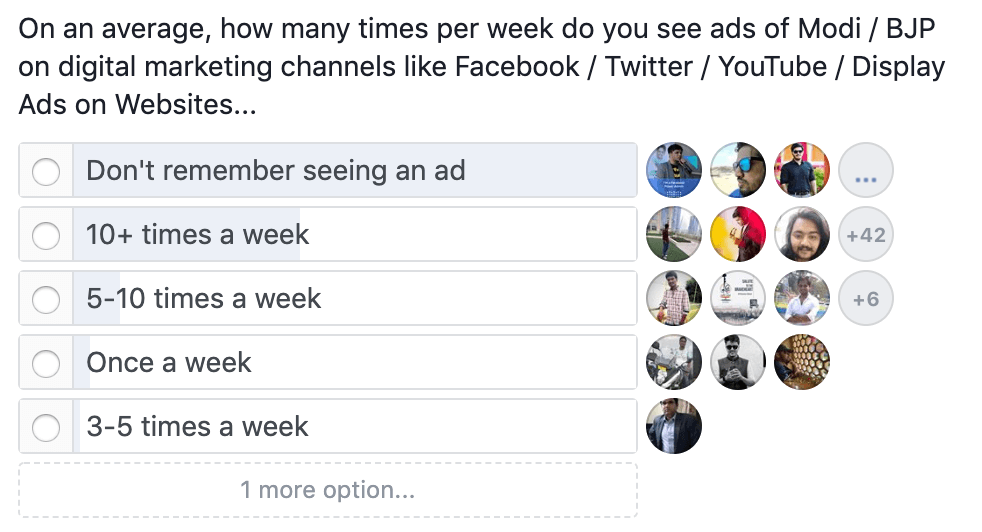
Though the ad spend looks like a lot, not everyone has observed ads. In a poll conducted in my Learn Digital Marketing Group, a majority of people have said that they do not remember seeing an ad for BJP in any of the social media marketing channels. A few people have observed ads more than 10 times a week.
Conclusion
The campaigning for the 2019 General Elections has a renewed online flavour to it altogether. All the parties are battling to grab eyeballs of citizens, convince them and convert them into voters and party advocates.
While each party is investing in its own way, the BJP is doing a noticeably remarkable job. The key highlights of BJP’s digital marketing strategy lies in their careful attention to minutest aspects.
Right from understanding and segmenting their target audience thoroughly, to delivering custom emotional messaging, to ensuring maximum reach – they are leaving simply no stone unturned. Their tactical execution is clearly top notch.
Their digital team has really invested efforts to ensure that their messaging is consistent, bold, clear and convincing. They have been leveraging almost all the content formats and platforms to conquer the digital influencing space, hitting the right chords of the different segments.
Which digital marketing strategy or executional tactic of the BJP appealed to you the most as a digital marketer? Let us know in the comments below.
Sources and References
- TheQuint.com – Congress vs BJP Battle in 2019 Will Play Out on Social Media
- IndiaToday.in – BJP’s Digital Raths to offer free internet to Delhi
- BusinessToday – Lok Sabha elections 2019: PM Modi launches BJP’s ‘Main Bhi Chowkidar’ campaign
- EconomicTimes – How the mobile phone is shaping to be BJP’s most important weapon in elections
- Hindustan Times – For PM Modi’s 2019 campaign, BJP readies its WhatsApp plan
- News18 – BJP Social Media Team Chalks Out Strategy to Counter Opposition Onslaught Ahead of Polls
- DailyO – What Congress needs to learn from BJP in the social media game
Disclaimer
This publication DigitalDeepak.com and the author – Deepak Kanakaraju have tried their best to publish factually correct information on this blog post. This publication DigitalDeepak.com and the author – Deepak Kanakaraju do not have any affiliation with any political parties.